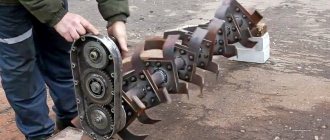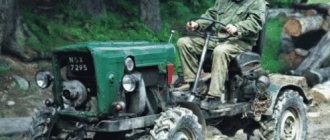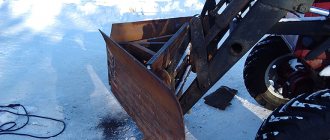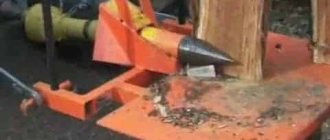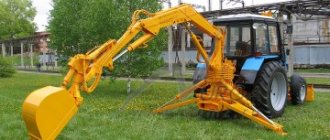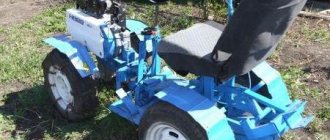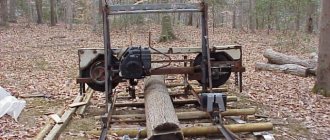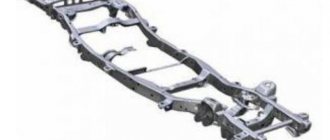Device
A mini tractor cutter is a fairly simple device that includes several working units. Here is their list:
- support frame with wheels;
- main shaft;
- cutting elements that are located on the shaft;
- gearbox;
- protective casing.
Device
However, the apparent simplicity is quite deceptive, because this equipment is very efficient and multifunctional. In particular, such a device can replace a harrow, plow and cultivator in one.
The very principle of its operation is as follows. When the minitractor moves, the drive wheels of the cutter transmit torque to the shaft with the cutting elements. These knives lift the top layer of soil and then turn it over. The principle is the same as when manually digging a garden using a shovel, but better and more efficient.
The force itself, which ensures the start of the movement of the shaft with knives, is transmitted from the main engine to the rototiller gearbox through the power take-off shaft. The gearbox itself transmits torque to the main shaft on which the cutting parts of the cutter are located.
Using the gearbox, you can also change the speed of rotation of the shaft, increasing or decreasing it.
The support wheels, in this case, perform a regulatory role, adjusting the depth of penetration of the cutting elements into the soil. Using the frame, aggregation is carried out with the hitch of the mini tractor located behind it.
The role of the casing is also quite clear - it prevents the working components of the device from getting dust and dirt on them.
Copy rings and templates
Devices for a hand router, such as copying rings, are a round plate with a protruding shoulder that can slide along the surface along the template, thereby ensuring the exact trajectory of the cutter. Often this element is attached to the base of the workbench. There are several ways to install it:
- Screwing the ring into a threaded hole.
- Installation of special antennae of the device into the holes on the sole.
If you have such a device for a manual router as a template, you can also achieve more accurate and efficient work. The said element is fixed directly to the workpiece itself with double-sided tape, after which both parts of the device are pressed to the machine using clamps. Upon completion of the work, experts recommend checking the condition of the ring - see whether it is securely pressed against the edge of the template or not.
Another feature of the tool in question is the ability to process not the entire edge, but only its corners. At the same time, some devices for a hand router allow you to make curves of four different radii at once. Thus, the process of cutting material using a template is an excellent way to cut grooves for a part.
Do-it-yourself cutter for a mini tractor
Since the soil mill is a simple design, it can be made independently, at home.
To assemble this device, you will need the following tools:
- welding;
- drill;
- Angle Grinder;
- spanners;
- bolts and nuts.
The first step is to produce a metal frame. To make it, you will need either an iron pipe or a metal channel, the diameter of the pipe must be at least 40 mm, and the thickness of the channel must be 5 millimeters or more.
The selected material is cut into 4 pieces, the resulting parts are welded together using a welding machine. The width of the resulting frame can be from 50 to 150 cm, depending on the power of the small tractor.
When creating a metal frame, the places where the support wheels will be installed are provided. They must be mounted in such a way that it is possible to adjust the distance of the cutter frame to the ground.
After securing the frame and installing the wheels, the shaft is secured to the frame at a distance of 30-50 centimeters from the ground, depending on the length of the milling knives.
To transmit traction force, the metal shaft is connected through a gearbox to the tractor power take-off shaft. The shaft must be secured to the welded frame through bearings and bushings.
Knives are made from strips of metal, the thickness of which is 10-12 millimeters. Experts recommend using only high-strength tool steel for the manufacture of metal knives, because they will experience the main load. Depending on the width of the shaft, use a suitable number of knives.
For example, for a device with a width of 120 cm, four elements are taken on which three legs are installed. Be sure to bend each leg at the end at an angle of 70-90 degrees; these bends will loosen the soil. The knives are secured to the shaft through threaded connections. All structural elements that will rub against each other must be lubricated with oil or grease.
We invite you to watch an interesting video about how to make a cutter for a mini tractor with your own hands:
How to replace a rototiller with a new one
Depending on the type of rototiller, its elements are replaced with new ones.
You must act in the following sequence:
- the metal casing is removed from the shaft;
- The shaft mounted on the mini tractor and the rototiller shaft are connected to the transmission transmission shaft. It is important to ensure that the axle pin is securely locked;
- a small tractor is rolled up as close to the cutter as possible;
- lift the connecting links located at the bottom of the device;
- The clamp plug is inserted into the connector. It is important for those connecting links that are located in the lower part to be securely connected to each other using a locking pin;
- the upper links are connected, they are also connected using a pin.
They disassemble the soil tiller and replace it with a new one according to the same procedure, only they do everything in the reverse order.
Homemade cutter for a mini tractor with your own hands from the Volga bridge
Using a bridge from a Volga car, a soil tiller is made for a small tractor, for example, a T-40. The width of the milling installation is 180 cm. First, a frame is made from metal corners or squares, the size of the frame is 180x60 centimeters, the base of the cutter will be installed on this frame.
The frame is welded on a flat plane so that there are no distortions, after which the washer and bearing are removed from the Volga bridge
The bridge is cut with a grinder to the length of the frame; it is important to cut at a right angle
The bridge is installed on top of the frame, and the cutting part of the cutter with knives is mounted at the bottom of the frame, the knives are secured to a metal pipe-axis, which is installed through bearings and secured to the frame using a plate.
Will need
We only need two M8 bolts and a washer with an outer diameter of 35-45 mm. By the way, the size of the bolt depends on the problem being solved. In our case, we select the future tool for a Forstner cutter to match the holes for a small ball bearing. It must be secured flush with the plane of the base. We will also make a clamp for pressing the element into the wood.
So, let's arm ourselves with power tools:
- Grinder (angle grinder) with cutting and grinding abrasive discs.
- Drill.
- Electric welding machine.
- Vertical drilling machine.
The hand tools we will need are: a file, a marker, and a caliper. Well, a workbench with a vice can be found in every workshop.
This is interesting: Making a stand for a drill with your own hands: instructions, drawings, video
Description
This type of attachment is quite common in the domestic agricultural market. Mostly, these are Russian and Belarusian units made in accordance with domestic quality standards.
FR-00010
I would like to start the description of the model range with FR-00010, manufactured at the Minsk Tractor Plant. It is clear that it is intended for MTZ mini tractors, but can also be mounted on other models that have a similar system for connecting attachments, for example Uralets, Kubota, Bulat 120, Yanmar, Belarus 132n, Scout.
FR-00010
This device can be used not only on light soils, but also on fairly heavy soil areas. It is allowed to use this cutter on slopes whose inclination does not exceed ten degrees.
Specifications:
- digging depth – up to 120 mm;
- width of the processed strip – from 440 to 610 mm;
- unit length – 65.5 cm;
- unit width – 68 cm;
- unit height – 47.5 cm;
- total weight – 47 kg;
- productivity on light soil – 0.18 hectares per hour;
- productivity on heavy soil – 0.12 hectares per hour;
- maximum speed – 3 km/h.
This cutter for a minitractor, the price of which will be about 24 thousand rubles, is intended for preliminary preparation of a land plot for its further use.
For more information about the operation of the FR-00010 cutter, watch the video:
FNM-1
FNM-1 is also produced in Belarus, like the previous model. It is used on a wide variety of soil types, but use on excessively inclined surfaces (up to ten degrees) is not allowed.
Specifications:
- digging depth – up to 80 mm;
- width of the processed strip – from 440 to 600 mm;
- unit length – 66 cm;
- unit width – 74 cm;
- unit height – 45 cm;
- total weight – 50 kg;
- productivity on light soil – 0.198 hectares per hour;
- productivity on heavy soil – 0.132 hectares per hour;
- maximum speed – 3 km/h.
This model will cost about 17 thousand rubles, depending on the pricing policy of individual online stores.
1 GQN-125
1 GQN-125 is a fairly powerful model, so it has certain requirements for a mini tractor, or rather, for its power. Nominally, it should be from 24 to 30 hp. It can be used on a wide variety of land areas, from light to heavy soils.
GQN 125
Specifications:
- digging depth – up to 200 mm;
- width of the processed strip – up to 1250 mm;
- unit length – 90 cm;
- unit width – 100 cm;
- unit height – 135 cm;
- total weight – 220 kg;
- maximum speed – 4 km/h.
The cost of this cutter is about 32 thousand rubles. In addition, this is not the only representative of this line. In addition to this, there are quite a lot of models that differ from each other in the width of the strip they process. In this case, the serial number will be identical to the given width.
Adviсe
Let's talk a little about tips that should be taken into account when creating homemade cutter models.
- To give the cutting area the correct configuration, you will need to use diamond-coated needle files or angle grinders with discs that are used specifically for working with metal.
- The edge for cutting should be sharpened at a 7-10 degree angle. If you make it sharper, then it will hold an edge poorly, which is why its cutting properties will significantly decrease.
- If a wood cutter made by yourself must have some kind of complex device, you can flatten it or bend it.
- When using an edge router, take into account that the guide ring or bearing is already installed.
- The cutter must be secured in the collet before starting work.
- The presence of additional accessories will help increase the power of the electric tool.
- The part to be processed must have some kind of support.
- When carrying out work, the correct insertion depth level should be set.
- To prevent too much dust from being generated when working, you can use a vacuum cleaner.
In general, it should be said that creating a wood cutter yourself is not difficult. True, it should be understood that in this way you can quickly solve some simple problem, because for hardware such as bolts, ordinary steel is used, not tool steel. This means that such a homemade cutter will quickly wear out. But its life can be significantly extended in a number of ways. Therefore, this solution has a place and should be used in cases where you really need to quickly acquire a pretty good wood cutter in order to get the desired result.
For more information on how to make a wood cutter with your own hands, see the following video.
Operating principle and types of cultivators with a cutter
The increased interest in implements with a rotary cutter is due to the opportunity to obtain high quality soil treatment in one pass of the working body of the unit. Cultivators of this type are especially popular when cultivating small plots of land for planting vegetables. The machine operates by dynamically loosening the soil by rotating an active body equipped with ripper knives.
Rotary cutter device
The supporting structure is a rectangular frame made of metal beams with a three-point attachment for the rear linkage of the tractor. Vertical posts are attached to the left and right sides of the frame, in the lower supports of which the active organ rotates on bearings. The cutter itself is a tubular shaft with knives pivotally attached to it. The cultivator is driven by an independent tractor PTO. The rotational moment on the cutter is distributed by the gearbox included in the cultivator through chain or gear drives. The rear bumper bar as part of the structure allows you to increase the degree of crumbling of soil clods. Its position regulates the degree of soil grinding. To prevent mechanism breakdowns when unacceptable loads occur, a safety clutch is installed in the drive structure. The depth adjustment is carried out by setting the level of the support wheels or shoes. For good penetration, some models are equipped with one or two powerful pointed arms, attached with their racks to the front beam of the cultivator frame.
Gear side transmission of tiller
Chain drive of tiller
Advantages of the cutter
The active rotating cutter of the cultivator, together with ideal loosening, ensures surface leveling, effective moisture retention in the soil, and crushing of the root system of weeds and crop residues of the previous crop.
- Processing with a milling cutter frees you from multi-operational preparation of areas for planting or sowing, that is, one pass replaces continuous cultivation and harrowing.
- Such complex processing reduces the time for soil preparation, which allows sowing or planting in a short agricultural time frame.
- In some cases, on well-groomed areas, with light physical composition of the soil, spring tillage with a milling cutter frees you from pre-autumn plowing.
- When processing, the cutter does an excellent job of incorporating organic fertilizers pre-distributed on the surface of the treated area.
Types of cultivators with a cutter
In addition to the design differences in the method of driving the device, the design of the cutter and the shape of the knives are fundamental, determining the nature of the processing with the fulfillment of agrotechnical requirements and the ability to work in special conditions.
According to the nature of soil cultivation, active organs are divided into:
- Vertical cutters - loosening with straight knives occurs in a vertical plane without turning the soil
- Horizontal cutters - soil is crushed using curved knives (L-shaped) with partial rotation
- Combined cutters with knives of various shapes that perform loosening, partial soil mixing, chopping weeds and crop residues
According to their purpose, cutters are divided into:
- Lightweight general-purpose working tools for continuous cultivation of plowed areas in preparation for sowing or planting with a processing depth of up to 15 cm,
- Heavy cutters designed for basic and pre-sowing tillage, for plowing turfy areas and virgin soil to a depth of up to 30 cm
- Mills for preparing for planting certain types of crops with the ability to install bed formers and hillers
- Cultivators with rotary cutters are capable of, in addition to loosening the soil, crushing roots and tall crop residues
- Cultivators with a cutter for continuous cultivation of rocky soils in mountainous areas
- Equipment with cutters for inter-row loosening of row crops
Elliptical and round grooves
To cut grooves in the shape of an ellipse or circle with a hand router, circular devices are used. A simple compass for a router can be made from a rod, the end of which is connected to the base of the tool, and the second is equipped with a pin or screw. To obtain a circle, the rod is inserted into the hole, which serves as the center, and then a groove is formed along the contour.
To change the diameter of the circle, you need to move the tool closer to the other end. A more convenient version of this compass uses two rods instead of one.
Such equipment is quite common and often comes complete with a router. With its help it is convenient to cut shaped grooves with different radii. And when it is necessary to obtain holes of small diameter, other equipment is used. Its peculiarity is that the pin, which is installed in the center of the workpiece, is located under the tool.
- The design of such a compass includes:
- A base that is fixed to the material being processed using screws or vacuum suction cups.
- Two rods.
- Two shoes that fit onto the guides.
- Bracket connecting the router and fixture.
Using the holes in the bracket, the support plate of the equipment is easily aligned with the tool. If a circle is being milled, then only one shoe is used, but for an oval, both are used. Cuts made with this addition are of a higher quality than those made with a band saw or jigsaw.
This occurs due to the characteristics of the tool, which rotates at a very high speed.
Tillage cutter: design and technical requirements
Reliable milling technology must meet certain standards. It must be reliable and easy to operate, multifunctional, efficient, and economical. All these qualities are due to its design.
Design features of the tiller
The tillage cutter meets all the requirements for equipment intended for tillage.
The main design elements include:
- metal frame with a coupling device (for connecting to a tractor);
- a shaft with cutting knives (they can be of different shapes - sickle-shaped, rotary, chisel-shaped);
- drive (through it, rotation is transmitted to the working parts from the base device);
- fencing (performs a protective function).
The design is easy to maintain, durable and functional.
Technical requirements for tillers
General technical requirements are set out in interstate standards GOST-28516-90:
- Plowing depth should be up to 12 cm in plowed fields and up to 18 cm in unplowed fields.
- The degree of weed crushing should be at least 95 percent.
- The degree of soil loosening/crushing is at least 85 percent.
- The unevenness of tillage is no more than 15 percent.
- The use of cutters on terrain with a slope of no more than 8° in fields and no more than 12° in orchards and vineyards.
- Ease and simplicity of the tractor coupling mechanism (quick coupling or semi-automatic device).
- The dimensions of the clutch mechanism must comply with GOST 25942.
- The design of the cutters should allow adjustment of the rotation speed.
- Knives and fasteners must be made of materials established by GOST, have an anti-corrosion coating and comply with a certain strength class.
- Welds must be of high quality and free from flaws.
- There should be no lubricant leakage in connections and seals.
- Availability of drive and transmission protection equipment.
Compliance of the equipment with these requirements guarantees its reliable and safe operation. When purchasing equipment, you need to be very careful about this issue.
We purchase a Chinese rotary cutter for the tractor
Almost always, a positive decision to buy a 1GN-180 rototiller is made on the basis of its low price, and additional incentives when choosing are:
— normal quality of this attachment;
— general unpretentiousness;
— ease of maintenance of the entire mechanism;
Indeed, these benefits actually exist and have been tested in our fields.
However, it is still worth paying attention to important technical aspects, making sure that the rototiller is factory-made in China, and comparing the differences between Chinese rotary cutters and European, Japanese and domestic manufacturers!
1) Equipped with a long driveshaft in a “case”;
2) Splined connection to the PTO of Chinese mini tractors;
3) The dimensions of the tiller knives are smaller in length/thickness;
4) Shipped disassembled;
5) The gearbox of the 1GN-180 cutter has no lateral displacement;
Of course, we know how to adapt such a soil tiller with T-40 tractors or MTZ-82.
How to make a homemade milling cutter from a bridge
The bridge from any passenger car is used as a basis.
All unnecessary elements that will not be used in the cutter are cut off from the bridge. The bridge is installed on a metal frame, which is manually welded from metal pipes or channels; the frame should be located on two wheels so that the bridge is at a height of 30-70 centimeters from the ground surface.
To secure the milling shaft, it is necessary to make homemade metal jaws from iron; the thickness of the metal used is from 8 to 12 millimeters.
To make the cutter shaft, a thick-walled pipe is taken, its diameter is about 50-60 millimeters. Several segments, from 5 to 10 pieces, are welded to the milling shaft, onto the ends of which knives, for example, “crow’s feet,” are welded.
On the shaft and on the bridge, 2 sprockets are installed on both sides, the number of teeth of which ranges from 18 to 28, two chains are put on the sprockets on both sides of the bridge and the shaft, the pitch of the chain must correspond to the pitch of the teeth on the sprockets.
The cutter shaft is fixed to the bridge using a metal plate about 10 mm thick. A protective metal casing is placed over the sprockets with chains. The chains must be coated with grease.
The simplest clamp for pressing
We will make this device from the same M8 bolt and a washer of suitable diameter. We place the bolt vertically on a metal surface, providing mass contact for electric welding. We place the washer on top in the center of the bolt head, holding it with pliers. We scald the center with an electrode, filling the area of the inner hole of the washer.
We clamp the resulting clamp in a vice and clean it with an angle grinder. The back part can be passed with a cleaning brush attachment for a drill.
We insert the finished clamp into the chuck of a vertical drilling machine, and try to press the bearing into the wood. This simple device will save you unnecessary effort and allow you to accurately handle such tasks.
Types of milling cutters for soil treatment
Despite their versatility, all commercially available cutters for tractors are divided among themselves according to their purpose.
According to this factor, equipment can be of the following types:
- cutters for continuous processing of the soil - these include garden, swamp and field devices used for uprooting stumps and plowing the soil before planting forest crops;
- specialized cutters designed for digging and cleaning trenches;
- inter-row cutters - these tools are used for plowing soil between rows during the period of active growth of crops:
- combined rototillers - these devices include milling-seeding and milling-row-crop complexes.
All of the listed types of cutters show the highest productivity in certain areas of operation. Their designs are designed to withstand the highest loads in the most difficult weather conditions.
Cutters:
The tiller performs milling, mixing, chopping, leveling the soil, killing weeds, chopping plant residues and driving organic fertilizers into the soil.
10 sections with forged knives made from springs effectively cope with loosening all types of soil. Due to the special shape, they easily enter the soil - the depth of immersion of the knives is adjustable.
The driveshaft is based on the rear axle of the Moskvich vehicle. Compatible with all types of tractors
Working width - 1.5 m
Cardan shaft - based on the rear axle of the Moskvich vehicle
Tillage depth is adjustable
Tractor type - any
Number of knives - 10 sections of 4 knives each
The tiller is designed to perform agricultural work on cultivating soil, both superficial and deep, to a depth of up to 28 cm. It is allowed to cultivate old arable fields, turfy meadows and pastures that do not contain stones.
It is also possible to use a rotary cutter for surface destruction of weeds and incorporation of fertilizers.
To cultivate virgin and fallow lands to the maximum depth, two-pass cultivation is used, with a stepwise change in the depth of cultivation.
Features and Benefits:
The processing depth is “on the bayonet of a shovel,” i.e. 25-28 cm.
There is no chain drive.
A large, powerful gearbox is installed, inside which is a bevel pair and a cylindrical row - this combination is more reliable. Thanks to this gearbox, the working depth reaches 28 cm.
A subsoiler paw is installed, which makes the cutter stay in the ground when moving, and not jump out (as in a Polish cutter).
Special limits have been established.
The tillage cutter is designed for pre-sowing cultivation of soil of various compositions, terrain slopes and individual uneven areas, for planting vegetable crops, without turning the layer against the background of plowed land or spring plowing. The cutter performs the following technological operations in one pass: milling the soil with active working parts, destroying weeds and leveling the microrelief. The tiller creates optimal soil density due to a high degree of crumbling, increases its biological and biochemical activity, improves all physical properties of the soil, which helps to increase crop yields.
Tillage cutter - operating principle:
The milling drum with knives, rotating around its axis, moves in a plane perpendicular to the axis of rotation. In this case, continuous loosening and grinding of the soil and turf is carried out to a depth of 16 - 20 cm. The milling drum, mounted on the shaft, consists of several disc sections, on each of which a blade is fixed.
Cutting grooves on narrow surfaces
The home handyman is often faced with the need to cut grooves for a door lock or hinges. As a rule, a chisel and a drill were used for this. But this procedure can be carried out much faster and easier if you use a milling cutter with special equipment. This design allows you to easily create grooves on narrow surfaces and is a flat base that is mounted on the tool.
And also two pins are additionally installed, which ensure the movement of the cutter in a straight line.
The main requirement for this design: the pins must be located in the center of the material being processed. If this condition has been met, then the groove will be located strictly in the middle. To shift the direction of processing, it is enough to put a sleeve of the required size on one of the pins. When using such an attachment, you must ensure that its edges are pressed tightly to the sides during processing.
If you need to cut a groove on a narrow surface, but there is no necessary equipment, then this problem is solved with the help of two boards. They are attached on both sides of the product in one plane. And the power tool itself is fixed with a parallel stop.
The use of such an attachment for a door hinge router allows you to:
- Make the most accurate notch without spending a lot of effort.
- Minimize the possibility of an error, the probability of which is very high without using a template.
What is the purpose of a mini tractor cutter?
One of the most popular and popular mounted units is the tiller. Today we will learn how to make a cutter on MTZ with our own hands. Including a milling cutter for a mini tractor from the Minsk Tractor Plant - MTZ 82.
A tractor cutter is a tool that can perform many different functions aimed at cultivating soil on different plots of land. The considered homemade rototiller for a mini tractor is recommended for use when working in areas where there are no large root systems of trees and large stones. The mini-tractor cutter is divided into 2 main types.
A tillage cutter for a mini tractor, equipped with saber-shaped knives, is the most common type of this attachment. The shape of the blades allows the equipment to easily cope with a large flow of tasks without the threat of harm to the health of the tractor driver. If such a tiller on a mini tractor hits a stone, the blades simply lift it and continue to work. For the manufacture of such equipment, very high quality steel is used. The cutter is dismountable, the unit can be assembled within a minute.
“Crow’s feet” is also a popular type of cutter for a Belarus mini-tractor. It is used when necessary to remove weeds from the soil and when working in virgin lands. The equipment has a significant drawback - low strength, the cutter requires repair work and special care.
Mini equipment is a faithful assistant in small private households. With its help it is easy to loosen, weed, harrow the soil. Thanks to replaceable equipment, there is no need to purchase a whole fleet of vehicles. For example, the listed work can be performed if you have a universal mounted mechanism - a rototiller. How to build it with your own hands will be discussed in the article.
The basis of the design is an engineering block with a drum and curved blades welded onto it. While the tractor is moving, the knives plunge into the ground in the cultivated area, lift it and turn it over. Essentially this is the same thing that is done with a plow or shovel.
A properly made do-it-yourself rototiller allows you to perform the following work even in difficult conditions:
- loosen the soil;
- mix soil of any density and composition;
- destroy weeds.
Using a mini-tractor with a rotary cutter, they cultivate virgin soil, long-abandoned fields, areas for planting vegetable and horticultural crops, flower beds and lawns. The technique is suitable for both small and large areas.
The tiller is a separate removable mechanism consisting of the following parts:
- frame with support shoes (skis);
- knives for work in the form of curved plates;
- shaft, gearbox and casing.
The knives are attached to the shaft of the rototiller and are driven through a transfer articulated telescopic shaft. The gearbox reduces the rotation speed and at the same time increases the power of the knives. Support shoes or skis regulate the working depth, preventing the knives from going too deep into the ground. The casing, which is installed on the frame, protects the mechanism from dust, lumps of soil and debris.
A rotary cutter, assembled with your own hands, can capture soil to a width of 80 to 140 cm. This is more than enough for cultivating a garden.
Step-by-step instruction
So, let's move on directly to considering the instructions for making the above-mentioned device.
- First, use a caliper to measure the residual distance on the bolt head relative to the bearing being installed. If we are talking about an M8 type bolt, then the size of the hat circle in this case will be 1.27-1.3 cm. The diameter of the handle is about 1.16 cm, which makes it possible to easily clamp it in the vast majority of modern drill chucks.
- The cap should be adjusted to the bearing diameter. It is this area of the bolt that will represent the working part of the cutter.
- For marking, it is better to use a thinner contrast marker; the main thing is that the marks that will be applied with it are easily distinguishable on the metal. Now we apply the markings of the cutter's burrs. This solution will allow her to get rid of shavings without much effort.
- After this, we clamp the bolt in a vice. Using a cutting wheel, we use a grinder to create slits on the cap.
- We measure the bearing diameter. To work the head of a bolt with a faceted surface to a circle, you should transform the drill into a lathe. To do this, you need to clamp it in a vice, and then firmly attach the bolt in the chuck precisely in the center.
- Now you should fix the drill key at a constant operating mode, after which you can begin processing the bolt head. This process must be controlled at all stages of its implementation in order to prevent the center of the bolt from moving, which can cause a violation of the uniformity of the operated teeth.
- After this, you should install an abrasive disc on the grinder for grinding and process the edges around the circumference. The end area of the cutter should also be removed a little, leaving only a slight sharpness in the center. This element is of great importance, because this type of cutter will first find the center when working, and only then will the material be triggered by the rims and edges of the cutting type. Here you can carefully refine everything using a file, so as not to accidentally cut off more than is necessary during the grinding process.
- The cutter itself will be almost ready. All that remains is to give the cutting edges the required shape, and then sharpen them a little.
For greater efficiency, it would be useful to make the simplest clamp for pressing. Therefore, the instructions for creating it also need to be considered.
- This device is also made from an M8 bolt and a washer of suitable diameter. The bolt should be placed vertically on a surface made of metal so that the required contact for electric welding is ensured. The washer must be installed in the center of the bolt head. To make this job easier, you can use pliers. After this, the central part will need to be treated with an electrode to fill the area of the inner hole of the washer.
- Now you need to clamp the clamp, which was obtained as a result of the above actions in a vice, and then clean it using a grinder. You can walk along its back using a special brush attachment for a drill.
- At the final stage, all that remains is to install the finished device into the chuck of a vertical drilling machine, after which you will need to press the bearing into the wood. Such a simple “gadget” will eliminate a number of inconveniences when using a homemade cutter.
By the way, an end mill for wood can be made not only from a drill, but also from a tube with thin walls.
In this case, the algorithm for creating it will be as follows:
- in this case, the workpiece will be a piece of pipe with a length of about 20 centimeters;
- on the side where the cutting edge will be located in the future (somewhere at a distance of 2 cm from its intended location), oval-shaped grooves should be made on both sides of the pipe;
- the future cutting part of the cutter itself will need to be shaped into a cone - it is ground at an angle of about 2-3 degrees;
- when clamping the workpiece in a vice, a cross-shaped cut should be made at its end area - this can be done using an angle grinder;
- From the side of the cutting part, you need to make grooves on the workpiece - right up to the oval holes made earlier.
Soil milling machine and crow's feet cutters for walk-behind tractor
A soil tiller for a walk-behind tractor is used to destroy weeds, intensively crumble soil, mix soil layers, level the field surface and wrap fertilizers. Milling cutters are used especially effectively when heavy, waterlogged soils are processed, silty layers are developed, hummocks are cut off, and meadows and pastures are improved.
Soil mill for walk-behind tractor
A tiller for a walk-behind tractor is used during the pre-sowing period in the spring, after moldboard cultivation. It is not recommended to use cutters on light soils to avoid spattering.
Externally, rototillers look like bent knives or sabers, which are attached to a shaft in a certain order. The shaft rotation speed reaches 200 rpm. It is hung on the back of the walk-behind tractor. The operation of the rototiller depends on the power take-off shaft. The cutter gives better results when the speed of movement increases.
Diagram and device of a cutter for a walk-behind tractor
Thanks to their saber-shaped shape, cutters for walk-behind tractors are safe to use. If the walk-behind tractor hits a root or stone, the cutters lift it like a car wheel, while continuing processing. If the cutters are straight, then they can catch on an obstacle and overturn the walk-behind tractor. The consequence may be the operator losing his balance and possibly falling onto the cutters.
The knives are attached to plates, which are welded to the shafts at various angles. Thanks to this, the cutters enter the soil smoothly, one at a time. This has a positive effect on the transmission of the walk-behind tractor.
Carbon steel is used to make knives. If you have access to a forge, using a spring, you can make such knives.
For the manufacture of other parts, the following steel grades are used: St-25, St-20, St-10, which are easy to weld.
Soil milling machines with crow's feet for walk-behind tractors
To give greater strength to the cutters, they are made of steel, all-welded and non-separable. These cutters are called crow's foot cutters for walk-behind tractors. They are successfully and effectively used when working with hard soil. They are installed on almost any motor-cultivator or walk-behind tractor.
The main thing is that the axle diameter is correct. Houndstooth cutters are ideally used when there is hard soil to plow it “under potatoes.” They are also used for prevention against garden pests (wireworms or Colorado potato beetles) or for quickly plowing the garden.
Crow's feet cutters are divided into 3 and 4 rows. If the axis diameter is 25 mm, 3-row cutters are used for motor cultivators Texas, Krot, Caiman, Neva, and 4-row cutters are used for walk-behind tractors Farmer, Salyut, Favorit. If the axis diameter is 30 mm, 4-row cutters are used for walk-behind tractors Cascade, Pubert, Master Yard, Neva.
Do-it-yourself active cutter for a walk-behind tractor
Typically, an active cutter for a walk-behind tractor is sold complete with the walk-behind tractor. But sometimes you need to get the job done using specialized cutters that are not sold anywhere. In this case, you need to make cutters for the walk-behind tractor yourself.
In this case, you can go two ways: make the cutter yourself or order production from a master. The first option is quite labor-intensive. But a little time and money will be spent on manufacturing the cutter, as well as the cost of materials.
The second option has a number of advantages: the master has all the necessary tools and materials, and as a result the cutter will be more practical.
First you need to think about the functionality and design of the cutter. To do this, you should familiarize yourself with the analogues. To achieve maximum functionality and safety, all design details must be taken into account.
If the cutter design contains figured or pobedite elements, their production is ordered in the workshop. And other elements are bought in the store or those that are available are used.
After all the parts are made, it is necessary to assemble a normally working cutter, which not everyone can do. Assembly must proceed strictly according to the drawings, without any deviations in the design. Otherwise, the cutter will constantly move to the side, which will greatly complicate the work.
Tools and materials
So, to create a wood cutter with your own hands, you will need to have a pair of M8 bolts, as well as a washer with an outer diameter of about 4 centimeters. Naturally, the sizes of the bolts will depend on the problems that need to be solved. If we are talking about a tool for a Forstner cutter made from a drill, then you should take into account that it must have holes for a small ball-type bearing. It should be attached flush with the base plane. In addition, you will need to make a clamp, which will allow you to press the element into the wood.
The tools you will need to have on hand are:
- drill;
- vertical drilling machine;
- electric welding machine;
- angle grinder with abrasive discs of grinding and cutting type.
If we talk about hand tools, you will need:
- calipers;
- marker;
- file;
- Desktop;
- vice.
Features of blade installation
For different purposes and tasks, most modifications of soil cutters provide different options for installing and fastening blades. Depending on where the bends of the knife blades will be directed from the center of rotation, you can adapt the cutter for:
Inter-row tiller for hilling
- combing;
- hilling;
- loosening;
- alignment;
- soil plowing.
In addition to the usual curved blades of knives, upon special order, the cutter can be equipped with sickle-shaped blades, which can be used to process even very hard layers of earth.
Precautions when working with a cutter
- You can start working with the equipment only after reading the instructions.
- Do not start working with the cutter if the blade bolts are not secured.
- You must not leave the cab while the cutter is on.
- The angle of installation of the hinges should not exceed 13 degrees.
- Considering that almost any technical data sheet contains a line in fine print stating that the technical characteristics of products may change without prior notice, it is worth considering from the manufacturer or seller the maximum of the parts and details you need.
Carbide cutter – component of machine tools
Carbide cutters: area of use, design features
We all need to do some work related to metal processing from time to time. This is especially true for owners of country houses and dachas. Drills and cutters made of hard alloys are used to make holes in metal parts and process metal surfaces.
Carbide cutters are used in most cases for processing various groove holes, as well as when working with metal products. Moreover, such products of the end variety are an integral part of the machines themselves. The wide range of all kinds of cutters, which differ in their design, size and scope of application, is amazing.
It should be noted that when choosing a product, you should know what the component will be used for in the future. For example, carbide end plates are subjected to perpendicular type surface treatment; angular - process inclined products, etc.
Wide variety of carbide cutters
All carbide cutters have a high degree of reliability and resistance to mechanical factors. Mostly for their production, materials with a predominance of tungsten are used, thanks to which it is possible to process hard and heat-resistant surfaces.
The main parameters by which cutters differ:
- form;
- diameter;
- dimensions;
- design.
How to do it yourself
Of course, buying a ready-made cutter is the simplest and most understandable action, which fully justifies itself. However, many people ask the question - how to make a cutter for a mini tractor with your own hands? The reason for this interest is, as always, the price of the finished device.
To simplify the process of planting potatoes in agriculture, they came up with such a convenient device as a potato planter. By clicking on the link, you will get acquainted with the potato planter for the walk-behind tractor.
The walk-behind tractor will help loosen the soil faster and more efficiently than by hand, which means achieving a wonderful harvest with minimal effort. The Viking walk-behind tractor is the best assistant for the economic farmer.
Modern grain crushers are quite compact and energy-intensive, they are easy to use and delight their owners. Here is all the useful information about a household grain crusher.
The starting price starts at 12 thousand rubles for a soil tiller, which prompts people to think like this.
In principle, this idea is quite easy to implement, because the device of the cutter is not so complicated. To do this we need a fairly standard set of tools:
- Bulgarian;
- welding machine;
- electric drill;
- bolts and nuts;
- spanners.
Once you have made sure that you have everything you need, you can begin preliminary preparations. A do-it-yourself cutter for a mini tractor, the drawings of which are presented below, is a fairly standard design, so there is no need to reinvent the wheel by inventing something new.
You just need to follow the technical advice and parameters necessary to assemble a quality device.
Drawing 1
So, let's look at the detailed algorithm of our actions:
It all starts, naturally, with the manufacture of the device’s support frame. For these purposes, we will need a metal pipe with a diameter of about 4 cm, or channels.
Frame
- We cut the existing material into four parts, which must then be welded to each other. Remember that the width of the frame will directly depend on the power of the engine used in the mini tractor. Therefore, if it is not powerful enough, it is better not to make a very large structure.
- It is necessary to provide for the installation of wheels in advance, with the help of which the depth of immersion of the shaft knives will be adjusted.
- Next, you need to attach the main shaft, which will rotate, to the frame. As a shaft, you can use an ordinary metal pipe, the diameter of which should be at least 5 cm.
- The cutter shaft is connected through a PK-1.6 gearbox, which is aggregated with the power take-off shaft installed on the mini tractor. The main shaft is fastened to the frame using bushings with support type bearings.
- Knives for a mini tractor cutter are made of metal plates, the thickness of which should be about 1.2 cm. Depending on the width of the shaft, the number of cutting elements will also be different. For example, if the width of the shaft is at least 120 cm, then four knives can be installed on it.
- Moreover, each knife consists of three cutting elements, the ends of which are slightly bent. These elements are fastened to the shaft using bolts and other fasteners.
- Basically, your homemade cutter for a mini tractor is assembled with your own hands. As a finishing touch, you need to lubricate all parts that will be subject to friction with grease.
Required Tools
Production does not require anything special. We will prepare the necessary materials and tools for the work:
- Small grinder with a circle of 125 mm;
- A piece of I-beam 180 mm long, 20-25 cm, or a sheet of iron 5 mm thick;
- Cutting disc;
- Cleaning disc;
- Cord brush for angle grinders with metal bristles;
- Chalk;
- Vise;
- Round bit with a diameter of 40 mm for drilling holes;
- emulsion coolant;
- 10 cm of square pipe 25*25 mm and 50 cm of profile 20*20 mm;
- 2 extended nuts and 2 regular nuts with a diameter of 8 mm, 2 bolts 8*40 mm;
- A piece of sheet iron 1-1.5 mm thick;
- Chuck for drill 1.5-13 mm with threaded connection;
- Tap M14;
- Clamping bolts with wings 8*20 mm - 2 pcs., 2 nuts 8 mm.
- Drills 8 and 10 mm;
- 2 bolts 8*10 mm.
Design Basics
With the advent of new technologies for tillage, the options for additional attachments for mini-tractors are increasing.
The leader in soil tillage accessories is the blade attachment, an ideal option with many possibilities. A mini-tractor with a rotary cutter is ideal for cultivating soil in greenhouses.
The soil cutter imitates manual digging with a shovel. Special “shovels” are installed on a shaft that constantly rotates, which, using a drive, plunge into the soil, lift it and transfer it. Most often, the width of the nozzle does not exceed 100–165 cm, and the working grip of these tools is 81–140 cm.
Additional equipment with a milling attachment can process virgin soil, hill up, form beds, and weed out
The most important purpose of any attachment with a milling cutter is to loosen the soil; such a tool is a special shaft with knives of different sizes
How to make a milling cutter for a mini tractor
Since the cost of a cutter is always sky-high, you can try to design an attachment with your own hands, especially since there is plenty of material on this topic on the Internet today, you can look at photo instructions, or you can pick up a video.
The cutter device consists of many blades, which can be made of steel sheet with a thickness of at least 12 mm, because the soil is most often heterogeneous. All components and connections must be installed with maximum rigidity, so special parts are needed. For example, the PK-1.6 pick-up stacker can be used as a gearbox. It is better to make the design of the cutter non-separable, but integral, so you can achieve strength in the nozzle.
The optimal speed for such a cutter should not exceed 4 km per hour. And the depth of surface treatment is usually regulated by skis. Knives can be made from KAMAZ springs; they will have to be turned on a machine. The cut knives must be installed on special connections. A homemade cutter made in this way will always operate at low speeds and will not turn the soil into dust. If you shave the right material for the design of your rototiller, then the blades for the minitractor rotary cutter will serve you for a long time and will not become dull.
Recommendations for making a homemade rototiller
- The design of the cutter is not very difficult to assemble and weld. But before starting production, you should study this attachment from different manufacturers. After all, everything is described there in detail and in detail about its design features.
- Prepare in advance the materials that will be used during assembly. If there are parts that you are not sure you can handle (for example, a chain for a cutter gearbox), it is best to order it from a craftsman or forge it yourself in a blacksmith’s workshop.
- The cutter must be assembled in the correct order. If you neglect this advice, you can assemble a rototiller that is unsuitable for work or break the axis of the mini tractor (it will tilt from one side to the other).
- Before installing the cutter on the tractor, you need to check that the teeth themselves rotate in the right direction.
- All manufacturers recommend using parts for assembly measuring 50 cm. Thanks to compliance with these parameters, your rototiller will be able to enter a depth of up to 26 cm with a working width of about 1 meter.
- The saber-type cutter is considered the safest. It is when using it that the tractor driver reduces the risk of injury. The knives themselves will enter the soil one by one without any jerking.
- Following simple operating rules helps extend the service life of any attachment, including cutters.
- Don't forget to use safety rules. They should never be neglected in order to avoid unforeseen accidents during loosening or cultivating the soil.
If you use it correctly and treat the equipment wisely, as well as constantly take care of the attachments, you can do without repair work for a long time.
